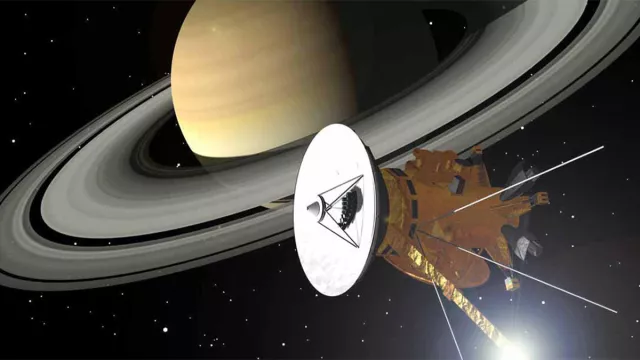Launched in 1997, Cassini-Huygens is the result of close cooperation between Europe and the United States and the first mission dedicated exclusively to exploring Saturn and its moons. In 2004, the Cassini orbiter deployed the Huygens probe to the surface of Titan, Saturn’s largest moon.
Key information
Key figures
- 12 instruments on orbiter
- 4 gravity assists en route to Saturn
- 5,712 kg total mass of orbiter and lander
- 6 instruments on lander
Key milestones
- 15 September 2017: Cassini plunges into Saturn’s atmosphere, marking the end of its mission
- 3 February 2010: NASA extends Cassini mission to May 2017
- 30 June 2008: NASA extends Cassini mission to 2010
- 14 January 2005: Huygens sets down on the surface of Titan
- 1 July 2004: Orbit insertion around Saturn
- 30 December 2000: Jupiter flyby and gravity assist
- 18 August 1999: Earth flyby and gravity assist
- 24 June 1999: 2nd Venus flyby and gravity assist
- 26 April 1998: 1st Venus flyby and gravity assist
- 15 October 1997: Cassini-Huygens launched by Titan IV-Centaur
- 25 November 1988: ESA joins mission with start of Huygens lander project
- 1982: Start of Cassini mission project
Project in brief
The planet Saturn has long been cloaked in mystery. To unveil Saturn’s secrets and those of its moons, the Cassini spacecraft departed Earth on 15 October 1997, carrying the Huygens lander to be released in the dense atmosphere of Titan, its largest moon. In July 2004, Cassini-Huygens arrived in the vicinity of the ringed planet and went into orbit. Cassini then began its mission to study the atmosphere, magnetosphere and rings of Saturn, as well as its moons (among them Titan, Enceladus and Rhea). A few months after going into orbit, Cassini released the Huygens lander, which studied the atmosphere of Titan for several hours before reaching its surface on 14 January 2005. Huygens’ descent and landing on Titan returned valuable data for scientists on the moon’s atmosphere and soil.
Developed by NASA, the Cassini orbiter had 12 instruments. The Huygens probe supplied by ESA as part of the Horizon 2000 programme had six. While France’s contribution to developing and operating these instruments was significant (CNES is helping to perform half of the experiments on the orbiter and lander), it chiefly concerned two instruments on Huygens in particular: ACP (Aerosol Collector and Pyrolyser), designed to analyse the chemical composition of aerosols and developed by the LATMOS atmospheres, environments and space observations laboratory in Paris-Guyancourt; and HASI (Huygens Atmosphere Structure Instrument), a suite of sensors designed to measure the properties of Titan’s atmosphere, whose principal investigator, Marcello Fulchignoni, was from the LESIA space and astrophysics instrumentation research laboratory in Meudon. Thales Alenia Space in Cannes built the Huygens probe as prime contractor for ESA.
Initially planned to last four years, the mission was extended several times through to September 2017, when Cassini performed a controlled entry into Saturn’s atmosphere, where it burned up.
CNES’s role
CNES contributed to half of the scientific experiments on the orbiter and lander.
CNES contacts
Solar System Planets and Small Bodies subject matter expert
Francis Rocard
E-mail: francis.rocard at cnes.fr


